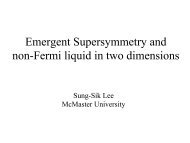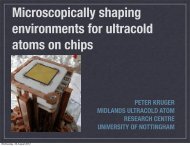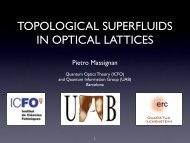Topological States of Matter - International Institute of Physics
Topological States of Matter - International Institute of Physics
Topological States of Matter - International Institute of Physics
You also want an ePaper? Increase the reach of your titles
YUMPU automatically turns print PDFs into web optimized ePapers that Google loves.
Natal 2012<br />
<strong>Topological</strong> <strong>States</strong> <strong>of</strong> <strong>Matter</strong><br />
Cristiane Morais Smith<br />
<strong>Institute</strong> for Theoretical <strong>Physics</strong><br />
Utrecht University<br />
The Netherlands
Introduction<br />
19 th century physics:<br />
thermodynamics, hydrodynamics, elasticity<br />
Classical states <strong>of</strong> matter (solid, gas, liquid)<br />
20 th century physics:<br />
Exotic states <strong>of</strong> matter<br />
Superconductivity, superfluidity<br />
Bose-Einstein condensates<br />
Quantum Hall fluids<br />
Graphene, topological insulators<br />
2D or coupled 2D planes<br />
Atoms or electrons
Integer Quantum Hall Effect (IQHE)
IQHE: Single-particle picture
Fractional Quantum Hall Effect
Cold atoms in optical lattices<br />
Quantum simulators <strong>of</strong> cond-mat systems:<br />
● Full control <strong>of</strong> lattice parameters<br />
● Select the lattice geometry<br />
● Load with bosons, fermions, or mixtures<br />
● Control <strong>of</strong> interactions (Feshbach resonances)<br />
● No disorder (or include it under control)
Until now: quantum phase transition from<br />
Superfluid to Mott insulator<br />
Holly grail: reach the quantum Hall regime with<br />
cold atoms<br />
Difficulty: rotate fast enough<br />
Recent developments: synthetic gauge fields<br />
(Raman excitations)<br />
New discovery: topological insulators
<strong>Topological</strong> states <strong>of</strong> matter<br />
Insulating bulk and conducting edges<br />
Quantum Hall effect:<br />
Magnetic field - Charge current<br />
[von Klitzing 1980]<br />
Quantum spin Hall effect:<br />
Spin-orbit coupling - Spin current<br />
[Theory: Kane and Mele 2005]<br />
[Expt: Molenkamp & Hassan]
Motivation: <strong>Topological</strong> states <strong>of</strong> matter<br />
Quantum Hall effect:<br />
Magnetic field - Charge current<br />
Break TRS (chiral)<br />
Quantum spin Hall effect:<br />
Spin-orbit coupling - Spin current<br />
TR invariant (helical)
Question:<br />
What happens when we have a<br />
Magnetic field and spin-orbit coupling?<br />
Trivial answer: destroy QSHE (break TRS)<br />
Non-trivial answer: look at the problem from the<br />
QHE perspective!!!!!
Outline<br />
I. Honeycomb lattice + mag field + spin orbit<br />
1. Introduction:<br />
QHE in a honeycomb lattice<br />
2. <strong>Topological</strong> phases and phase transitions<br />
Zeeman effect<br />
Intrinsic spin-orbit coupling<br />
Rashba spin-orbit coupling<br />
Combinations<br />
3. Experimental realizations<br />
II. Shaken honeycomb optical lattice
Introduction – QHE in a honeycomb lattice
Spectrum
Spectrum
Edge state analysis
Model – Zeeman effect and SO interaction<br />
W. Beugeling, N. Goldman, and C. M.S., PRB 86, 075118 (2012)
Model – Zeeman effect and SO interaction
Model – Zeeman effect and SO interaction
Different effects <strong>of</strong> ISO and Rashba<br />
ISO: opens a gap<br />
Van Gelderen and CMS, PRB 2010<br />
Rashba: lifts spin degeneracy
Q: Does the QSHE at E = 0 survive<br />
when we apply a magnetic field?<br />
A: Yes!!! The gap remains robust<br />
and the Chern number also.<br />
However, because TRS is broken,<br />
helical edge states may scatter.<br />
We call this state “weak” QSHE
Intrinsic SO + B: weak QSHE
Zeeman effect: weak QSHE
Combined effects: ISO + Zeeman<br />
weak QSHE
<strong>Topological</strong> phases – Zeeman effect
<strong>Topological</strong> phases – Zeeman effect
<strong>Topological</strong> phases – Zeeman effect
<strong>Topological</strong> phases – Zeeman effect
<strong>Topological</strong> phases – Intrinsic SO
<strong>Topological</strong> phases
<strong>Topological</strong> phases
<strong>Topological</strong> phases – Rashba SO
Rashba SO + B: trivial gap
Rashba: spin-textures
<strong>Topological</strong> phases
Q: Do we really need a uniform<br />
magnetic field to get QHE?<br />
A: Haldane (1989): No, it is enough<br />
to break TRS (staggered flux)<br />
Q: Is this all???? Do I really need to<br />
break TRS?
Yes: Rashba + exchange (B = 0):<br />
QHE
Experimental realizations
Experimental realizations: condensed matter
Experimental realizations: quantum dots<br />
A. Singha et al (Pellegrini's group), Science 332, 1176 (2011)<br />
Manoharan: Nature 483, 306 (2012)
Synthetic graphene<br />
●<br />
●<br />
●<br />
●<br />
CO molecules on<br />
Cu(111)<br />
2DES<br />
Move CO with<br />
STM<br />
Electrons form a<br />
honeycomb<br />
lattice<br />
Manoharan: Nature<br />
483, 306 (2012)
Experimental realizations: ultracold atoms
Experimental realizations: SO with<br />
ultracold atoms<br />
Lin, Gimenez-Garcia, Spielman, Nature 471, 83 (2011)<br />
Only a part <strong>of</strong> the Rashba term (actually, Rashba + Dresselhaus)
Ultracold atoms: shaken, not stirred!
Manipulating Dirac points<br />
Cheol-Hwan Park et al., Nature <strong>Physics</strong> 4, 213 (2008)<br />
P. Dietl, F. Piechon, and G. Montambaux, PRL 100, 236405 (2008)<br />
Lih-King Lim, CMS, and A. Hemmerich, PRL 100, 130402 (2008)
Merging <strong>of</strong> Dirac points in a shaken<br />
honeycomb lattice<br />
Static honeycomb lattice:<br />
3 lasers with 120 degrees<br />
to create optical lattice *<br />
Ultracold atoms at minima<br />
Shaking: moving along<br />
directions 1 or 2 **<br />
S. Koghee et al., PRA 85, 023637 (2012)<br />
* Sengstock group, Hamburg, 2010<br />
** Arimondo group, Pisa, 2009
Shaken in 1D: Theory<br />
Hollthaus, Eckardt, Hemmerich
Shaken in 1D: Arimondo group (Pisa)
Theory<br />
Graphene Hamiltonian:<br />
Shaking:<br />
Effective Hamiltonian:<br />
Renormalized NN hopping<br />
NNN also changes
Experimental observation<br />
Nature 483, 302 (2012)<br />
See also theory by<br />
Lim et al, PRL 108, 175303 (2012)
Shaken optical lattice: merging and alignment <strong>of</strong> Dirac points
Utrecht group members (graphene)<br />
Wouter Beugeling Ralph van Gelderen Selma Koghee<br />
External collaborators: Brussels and Orsay (Paris)<br />
Nathan Goldman<br />
Mark Goerbig<br />
Lih-King Lim
Experimental collaborators<br />
HAMBURG<br />
UNIVERSITY<br />
Andreas Hemmerich<br />
Ian Spielman<br />
NIST







